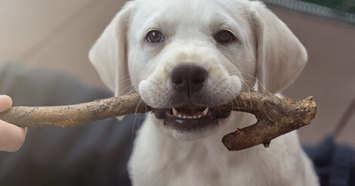
There are few things about owning a puppy as frustrating as teething. When they’re young, they figure out the world using their mouths and the approximately 28 knives (aka teeth) that they have in there. This means that nothing is safe from chewing, not your toes, your clothes, your furniture, and even your remote controls. If you’ve got the puppy teething blues, you’ll want to keep reading.
When Teething Happens
Puppies get their baby teeth as young as two weeks old. Chances are that you picked up your pup from the breeder or rescue with the puppy teeth already fully grown in and ready to chomp. Puppy teeth are like razor blades, slicing through everything they can sink them into. These baby teeth fall out between three and four months old to make room for the 42 replacements. By six months old, your puppy should have lost all his puppy teeth and have most of his adult teeth.
Puppy Teething Symptoms
Signs that your little one is teething include:
Drooling
Excessive chewing
Pawing at the mouth
Leaving blood spots behind on their latest chewed victims
Be mindful that these are normal when puppies are teething, but if there is more drool, chewing, or blood than usual it could be a sign of a deeper underlying issue. Teething can also make puppies sick, causing a decrease in appetite, upset stomach, or unusual stools. However, these symptoms shouldn’t be long-lived; if your puppy is displaying these symptoms for a prolonged period of time, act accordingly. You should consult your veterinarian if you have any concerns.
How to Help Your Teething
The best news about all of this is that you can help train these bad habits out of your teething puppy. If your fur baby is chewing on things that he shouldn’t be, give him a distraction. You can initiate a play session to get his mind on something else, or hand him one of his own toys. KONG toys make a great puppy teething toy because of their durability. Pro tip: Put the KONG in the freezer to help alleviate some of your puppy’s teething pain
Your skin is also an in-demand chew toy for your teething puppy. This means toes, fingers, faces, and any other bit of exposed skin is fair game. While playing with other dogs, their way of saying “back off!” is through a yelp. When your puppy bites or nips at you, let out a loud “ow!” to let him know that he’s bitten too hard. When he retreats, reward him to show that he did the right thing. At this point, you can also give him a chew toy as a replacement.
If your pup is in pain, he’ll tell you by acting out, drooling, and nipping. You can opt to give him some puppy teething gel. This will numb his gums to take away the soreness he’s feeling. If he won’t let you put it right on his gums you can always put a little in his Kong or on another favorite teething toy.
Teething is a normal part of puppy-hood and can quickly pass with the right attention. It doesn’t hurt to train your puppy alongside his teething stage as it can serve as an welcome distraction. Check out Embrace’s behavior and training articles for advice and more!